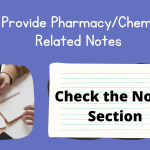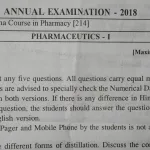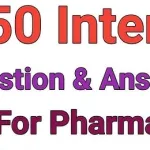This article provides a detailed set of questions and answers for D Pharmacy exams. It covers various subjects in the D Pharmacy curriculum, offering both theory and practical-focused questions, helping students prepare effectively for their exams. The answers are explained in a simple and understandable manner.
Pharmaceutics
Question: What is Pharmaceutics?
Answer: Pharmaceutics is the branch of pharmacy that deals with the formulation, preparation, and dispensing of drugs. It focuses on the design and development of drug delivery systems.
Question: What are the types of dosage forms?
Answer: Dosage forms include solids (tablets, capsules), liquids (syrups, solutions), semisolids (creams, ointments), and aerosols (inhalers).
Question: Define excipients in pharmacy.
Answer: Excipients are inactive substances used in the formulation of drug products. They help in stabilizing the active ingredient and improve the manufacturing process.
Question: What is the purpose of a suspension?
Answer: Suspensions are liquid dosage forms in which solid particles are dispersed throughout a liquid. They are used for poorly soluble drugs to improve bioavailability.
Question: What are the different routes of drug administration?
Answer: Drugs can be administered via oral, topical, intravenous, intramuscular, subcutaneous, and inhalation routes, depending on the desired effect.
Question: What is meant by controlled-release dosage forms?
Answer: Controlled-release dosage forms are designed to release the drug at a specific rate, providing a sustained therapeutic effect over a longer period.
Question: Explain the process of tablet manufacturing.
Answer: Tablet manufacturing involves mixing the active ingredient with excipients, followed by granulation, compression, and coating, if necessary, to produce the final tablet.
Question: What is a solution in pharmaceutics?
Answer: A solution is a homogeneous mixture of a drug and a solvent, where the drug is completely dissolved in the solvent, making it easy to administer.
Question: Define emulsions.
Answer: Emulsions are liquid dosage forms containing two immiscible liquids, typically oil and water, stabilized by an emulsifying agent.
Question: What are suppositories?
Answer: Suppositories are solid dosage forms designed to be inserted into body cavities, where they melt or dissolve to release the drug.
Question: Describe the role of stabilizers in drug formulation.
Answer: Stabilizers prevent the degradation of active pharmaceutical ingredients, ensuring the drug maintains its efficacy and shelf life.
Question: What is the significance of the pH in drug formulation?
Answer: pH affects the solubility, stability, and absorption of drugs. It is important to consider the pH when formulating drugs to ensure maximum therapeutic effect.
Question: What are ointments and their uses?
Answer: Ointments are semisolid preparations used for topical application. They provide prolonged drug contact with the skin and are used for localized treatments.
Question: Explain the difference between a cream and an ointment.
Answer: Creams are emulsions with a higher water content, while ointments have a higher oil content and are greasier and more moisturizing.
Question: What is a parenteral drug?
Answer: Parenteral drugs are those administered by injection or infusion, bypassing the digestive system for quicker absorption and more controlled dosing.
Question: What is the significance of solubility in drug formulation?
Answer: Solubility affects the drug’s absorption and bioavailability. Drugs must be formulated in a way that enhances their solubility for effective therapeutic action.
Question: Define pharmacokinetics.
Answer: Pharmacokinetics is the study of the absorption, distribution, metabolism, and excretion (ADME) of drugs in the body.
Question: What are the factors affecting drug absorption?
Answer: Factors include the drug’s chemical properties, route of administration, formulation, and the health status of the patient.
Question: What is the role of preservatives in pharmaceutical products?
Answer: Preservatives prevent microbial contamination, ensuring the safety and stability of pharmaceutical products during storage and use.
Question: What is the purpose of packaging in pharmaceuticals?
Answer: Packaging protects drugs from physical damage, contamination, and degradation, ensuring that they remain effective and safe for use.
Pharmacology
Question: What is pharmacology?
Answer: Pharmacology is the study of drugs and their effects on the body, focusing on how drugs interact with biological systems to produce therapeutic effects.
Question: Define drug absorption.
Answer: Drug absorption is the process by which a drug passes from the site of administration into the bloodstream, allowing it to be transported to its site of action.
Question: What is bioavailability?
Answer: Bioavailability refers to the proportion of a drug that enters the bloodstream when introduced into the body and is made available for therapeutic action.
Question: Explain the concept of drug half-life.
Answer: Half-life is the time it takes for the concentration of a drug in the blood to decrease by half. It is an important factor in dosing schedules.
Question: What are receptors in pharmacology?
Answer: Receptors are proteins located on the surface or inside cells that bind with drugs to produce a biological response.
Question: What is the difference between agonists and antagonists?
Answer: Agonists activate receptors to produce a response, while antagonists block receptors, preventing the response from occurring.
Question: Describe the pharmacodynamics of a drug.
Answer: Pharmacodynamics involves the study of the effects of drugs on the body and how they exert their therapeutic effects at the molecular, cellular, or organ level.
Question: What is the concept of drug tolerance?
Answer: Drug tolerance occurs when the body becomes less responsive to a drug over time, requiring higher doses to achieve the same effect.
Question: What are side effects of drugs?
Answer: Side effects are unintended, often adverse reactions to a drug that occur in addition to the desired therapeutic effect.
Question: Explain the difference between pharmacokinetics and pharmacodynamics.
Answer: Pharmacokinetics deals with the absorption, distribution, metabolism, and excretion of drugs, while pharmacodynamics focuses on the drug’s effects on the body.
Question: What is the first-pass effect?
Answer: The first-pass effect refers to the metabolism of a drug in the liver before it reaches systemic circulation, which reduces its bioavailability.
Question: What is therapeutic index?
Answer: The therapeutic index is the ratio between the minimum effective dose and the minimum toxic dose of a drug. A higher index indicates a safer drug.
Question: What are the different types of drug interactions?
Answer: Drug interactions can be classified as pharmacokinetic (affecting absorption, distribution, metabolism, or excretion) or pharmacodynamic (affecting the drug’s effects).
Question: What is the role of enzymes in drug metabolism?
Answer: Enzymes, particularly those in the liver, play a critical role in metabolizing drugs, converting them into more water-soluble forms for excretion.
Question: What is the concept of drug synergy?
Answer: Drug synergy occurs when two or more drugs interact in such a way that their combined effect is greater than the sum of their individual effects.
Question: What is drug dependence?
Answer: Drug dependence occurs when a person becomes physically or psychologically reliant on a drug to function normally.
Question: What are contraindications in pharmacology?
Answer: Contraindications are conditions or factors that prevent the use of certain drugs due to the risk of adverse effects or interactions.
Question: What is the role of pharmacogenetics in drug therapy?
Answer: Pharmacogenetics studies how genetic variations affect drug metabolism and response, allowing for personalized medicine to improve treatment outcomes.
Question: How do drugs affect neurotransmitter activity?
Answer: Drugs can influence neurotransmitter activity by either mimicking the action of neurotransmitters or inhibiting their effects, altering mood, behavior, or bodily functions.
Conclusion
The D Pharmacy exams require a comprehensive understanding of various subjects, including pharmaceutics and pharmacology. This article provides valuable insights, aiding students in exam preparation. By reviewing these questions and answers, students can strengthen their knowledge and boost confidence in their studies.
Latest Posts
- Step-by-step guide to download and apply for jee mains admit card 202
- Comprehensive 2025 government holidays and recruitment details for job seekers
- JEE Mains Admit Card 2025: Your Step-by-Step Guide to Downloading the Hall Ticket
- Everything You Need to Know About 2025 Government Holidays Recruitment
- Comprehensive Guide to rrb d group recruitment 2025 – Eligibility, Vacancies, and Application
- Detailed guide to nps trust recruitment 2025 vacancies, eligibility and apply process
- Comprehensive guide to hpcl recruitment 2025 notification, vacancies, and application process
- ignou bed admission 2025 complete recruitment guide with eligibility and process
- Comprehensive Guide to Indian Army Agniveer Recruitment 2025 Notification and Jobs
- Everything You Must Know About CBSE Board Exams 2025 Changes & New Rules






